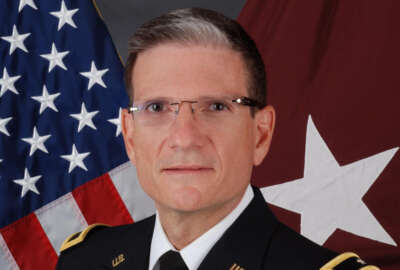
Congressional commission calls for sweeping changes to military, public service programs
After nearly three years of work, the National Commission on Military, National and Public Service last week released a long list of recommendations for all three...
Best listening experience is on Chrome, Firefox or Safari. Subscribe to Federal Drive’s daily audio interviews on Apple Podcasts or PodcastOne.
Editor’s note: The Partnership for Public Service published an open letter to President Donald Trump on April 2 welcoming the Commission’s final report.
After nearly three years of work, the National Commission on Military, National and Public Service last week released a long list of recommendations for all three areas of service. Commission Chairman Doctor Joe Heck joined Federal Drive with Tom Temin with highlights of particular interest to the federal workforce.
Interview transcript:
Tom Temin: Dr. Heck, as always good to have you on.
Joe Heck: Hey, thanks, Tom. I’m glad to be back with you.
Tom Temin: It’s sad a little bit that the timing of this really important report came out in the midst of this national crisis. I hope you don’t feel too slighted by the coronavirus.
Joe Heck: Well you know it has made for a challenging environment to release our report. However, in an odd way, it almost underscores the importance of our recommendations because we talk in our report about the importance of service, about the importance of public service and when you think about all the incredible work being done right now, in response to this crisis by public servants across the spectrum, whether they’re first responders in local communities or the scientists at NIH, the administrators at the FDA, epidemiologists at CDC, air traffic controllers, it’s all about service.
Tom Temin: Who wouldn’t want to grow up and go to med school and become Dr. Anthony Fauci these days?
Joe Heck: Yeah as you know, I’m a physician by training, and I’ve always had a long standing respect for the work that he does.
Tom Temin: Alright, let’s talk about the report a little bit. I wanted to focus in on one of the recommendations, which is to improve military outreach and strengthening military recruiting and marketing. A few themes in there. Tell us what the – what the thinking is behind that one.
Joe Heck: Sure, well as your listeners undoubtedly have heard before, only 29% roughly of the population between the ages of 17 and 24 which is the prime recruiting demographic, actually qualify for military service. When you think about the numbers more broadly, it’s about 32 million individuals in that age cohort. Every year when you look at the number that are not medically disqualified, or legally disqualified due to whatever issues that drops to 9 million. When you look at those that are then highly academically qualified, which means basically being an A or B student in high school, that drops to 4.5 million. And then when you go from that 4.5 million and you ask, how many of you have thought about serving in the military? It drops to 450,000. And we are competing, the military is competing against Fortune 500 companies and top colleges and universities for that same potential pool of applicants. So our recommendations are focused on that 4.5 million. How can we get more of the folks who are physically and academically qualified to consider serving in the military? So part of it is increasing awareness about military opportunities. Post 9/11, bases closed their gates. It’s much more difficult to get access. So there’s an increasing civil military divide where individuals just don’t understand deeply what the military does. Most youths are getting their perception of the military from TV shows, movies and playing video games like [Call of Duty]. They don’t understand that any possible job that’s available in the civilian sector is also available in uniform. We want to expand junior ROTC programs, which, although are really a citizenship program, not a military program, helped introduce more youth to a potential career and service in the military. So there are several recommendations at how we can increase awareness not just for the potential recruit, but also for the influencers – the parents, the coaches, the religious leaders, guidance counselors in high schools – to try to make sure that they include an option for military service as their child is considering what to do, post-high school.
Tom Temin: Sure, so if you could expand that 400,000 by 10 times, then it would certainly ease the recruitment stresses that the military feels every year.
Joe Heck: Yeah, without a doubt. And so they – our vision for that is that we would be so successful that there would really be no need for the traditional recruiting methods that are currently out there, right, that there would be so many people interested that they’ll just freely walk through the door and continue to volunteer as they have done. Since the institution of the all-volunteer force, which has provided us with the most professional and capable force in our nation’s history.
Tom Temin: We’re speaking with Dr. Joe Heck. He is chairman of the National Commission on Military, National and Public Service. And also, effectively managing the military personnel that are already in there, is one of your recommendations. What do you envision as some of those steps?
Joe Heck: Well, you know, so certainly once we spend the time to increase awareness and get folks to sign up we want to make sure that we keep them as long as we can, and as long as they want to stay in uniform. So we look at providing more flexibility, to the ways that military members can serve. We support a lot of the human resources and human capital management recommendations that previous Secretary of Defense [Chuck] Hagel had tried to institute. We want to make sure that we provide those that are serving with the opportunity to remain in a meaningful way in the service for as long as they’d like to stay.
Tom Temin: All right. And then I wanted to ask you also about the recommendations regarding the career civilian workforce. You mentioned that modernizing veterans preference with the emphasis on modernizing, expanding noncompetitive eligibility, but also developing a new personnel system. Lots of moving parts there. Because a personnel system is, by nature in the federal space, competitive.
Joe Heck: It certainly is. And this is a great issue. So again, probably no surprise to those that listen to your show. But when you look at the federal civilian workforce, only about 6% is under the age of 30. That’s roughly half the amount that’s in the general population workforce, and about 1/3 of the parent federal workforce will be eligible to retire in the next five years. And so we have this kind of restricted pipeline of individuals coming into the federal workforce, and we have a potential brain drain on the back end and we, again, want to make sure that we have the best and brightest that are doing the jobs that are necessary to keep our government functioning. So again, we look at how can we increase awareness amongst AH, high school and college students to consider a career in public service? One of the things we heard as we traveled around the country and talk to folks, we actually went and visited the the federal center out in Denver, Colorado, which is the largest concentration of federal employees outside of Washington, D.C. And spoke with many of the folks there. You know, one of the biggest obstacles is actually the USAJobs platform. I mean, when you try to go in and submit a, you know, application via USAJobs for today’s millennials and Gen Zers it’s just far too many mouse clicks. It’s not the way in which they are used to interacting with entities with whom they are interviewing for jobs. So we’re at a disadvantage there. So we want to change the process by which we assess new applicants into the federal workforce. Again, once we have them in the federal workforce, how can we keep them right? So it means a more flexible benefit package that’s somewhat competitive with what the options are in the private sector. You mentioned the veterans preferences. So we enhanced and modernized – the veterans recommend a modernization and enhancement of veterans preferences so that more veterans can actually utilize the preference which they’ve earned with their service. Over time, the veteran’s preference has been circumvented by direct hiring authority by non competitive eligibility, and so very few veterans actually get an opportunity to utilize the preference to get into the federal workforce. And we want to target that preference for those veterans that are recently separated from the service to give them the opportunity to get into the federal workforce as they transition from active duty into civilian life. We also look at creating a more high performing personnel culture, right? We need, um, the hiring managers more involved with the evaluation of their applicants and with the evaluation of their employees. So again, a whole host of recommendations. Interestingly, we have 164 total recommendations in the report. The largest individual group of recommendations by topic deal with modernizing the public service sector.
Tom Temin: Yeah, because it sounds like there are issues that can be done by executive order or just by simply better management on the part of the career civil servants. And then there are some things that do require congressional work. And the congressional work might be the, I don’t know is that the heavier lift or is it the easier thing?
Joe Heck: Well you know, we were trying to make it as easy as possible for the members of Congress, both House and Senate. So we actually as part of our report how the legislative annex that takes every one of our recommendations and puts them into actual bill language. So if there’s somebody who actually has an interest in adopting some of the public service recommendations the bill is already drafted for them. They just need to drop it into the hopper. And so you certainly, some can be done by policy, some can be done by executive order. I think the important thing is that this is a holistic and comprehensive review, right. In the past, having served in Congress, I’ve seen where, you know, incremental changes made or a little nibble around the edge to try to make a change and often times trying to make that small change meets with more resistance because there’s a second or third order unintended effect. What we’ve done is looked at the issues holistically and comprehensively so that we’ve tried to minimize the friction points by making a change in one place that might have a ripple effect in another place.
Tom Temin: And what happens to the report now that it is delivered and what happens to the commission?
Joe Heck: So the – we disband in September of this year. So we were given a three-year tenure to complete our work. As we mentioned we submitted the report to Congress and the president last week. We did have a congressional hearing scheduled. However, with the current crisis and the cessation of in-person testimony, those will be postponed. Hopefully, we will be able to get in front of the committees of jurisdiction as soon as things return to relative normalcy to be able to present our recommendations. Last week, we did pre-brief many of the leaders in both the House and the Senate on their respective committees of jurisdiction, also thought leaders within the House and Senate on many of the issues that we discuss. And so we will continue to work with them in a virtual environment until we have the opportunity to actually testify and present the report to them in person. And then, lastly, as we transition out at the end of September, we will hope that stakeholder organizations that have an interest in these topics will continue to carry the guide on. Our vision is a vision 2031. We hope that over the course of the next 10 years, that by 2031, 5 million Americans will enter into some form of service every year. We know that that is a generational change, changing the way people think about service. We pick 2031 because in year 2031 that will be the 70th anniversary of President Kennedy’s speech, in which he said, “Ask not what your country can do for you, but ask what you can do for your country.” And so we have recommendations laid out over that timeline, gradually building to the point where by 2031 there will be a universal expectation of service of all Americans and that it will not be uncommon for someone to come up to you and say, “So where you gonna serve?”
Tom Temin: Wow. Well, it’s ambitious. Let’s hope some of it at least can happen. Dr. Joe Heck is chairman of the National Commission on Military, National and Public Service. Thanks for joining me and thanks for your own service.
Joe Heck: Thank you, Tom.
Tom Temin: Find a link to the report and to this interview at www.federalnewsnetwork.com/FederalDrive. Subscribe to the Federal Drive at Apple Podcasts or Podcastone.
Copyright © 2025 Federal News Network. All rights reserved. This website is not intended for users located within the European Economic Area.





